The Best Yoga Mats for Any Practice, According to Instructors

Our editors independently select the products we recommend. We may earn a commission on items bought through our links.
Let’s face it: When you’re contorting your body into pretzel-like shapes, the last thing you need is a slippery, flimsy excuse for a mat sending you sprawling onto your neighbor’s during a class. And no one wants to be that guy in the corner desperately trying to maintain his warrior pose on a gross mat that’s seen better days. Whether you’re a rookie or a seasoned yogi, a proper yoga mat to keep you safe and centered (quite literally) to reap the benefits of your session.
Today's Top Deals
But investing in the right yoga mat isn’t just about avoiding embarrassing faceplants. It also symbolizes a readiness and commitment to practice, says Nicholas Duran, an E-RYT 200 certified yoga instructor, NASM-certified personal trainer, and fitness and movement pro at Equinox and Heroic Performance Fitness in Los Angeles. “For me, a mat symbolizes a time when I’m trying to center myself and tune in on my body,” he says. “Part of that is being on my own mat. It forms a continuity of practice.”
Plus, a solid mat can serve your focus and frame of mind, too. “You end up forming a bit of a connection with your mat,” Duran continues. “It becomes this little space that signifies, ‘OK, this is yoga time’.”
Forget the basic mats you thought you knew. Today’s yoga mats are thicker, grippier, and more moisture-resistant than ever before, designed to withstand the sweatiest of sessions, and indoor-outdoor environments, and serve workouts beyond yoga. And the great news? It’s possible to score a high-quality mat in a variety of lengths, comfortable materials, and your preferred thickness at a budget-friendly price (starting at $20) or a more premium one (around $100).
Choosing can feel overwhelming but fear not, yoga warriors: With the help of yoga and fitness experts, SPY researched the best yoga mats for any practice, no matter how you’re getting your “om” on.
What the Experts Say
SPY asked fitness experts — Duran and Brette Berlin Scott, an E-RYT 500 yoga instructor and owner of Shakti Yoga in Des Moines, Iowa — to weigh in on the best yoga mats for peace of mind and stability for any practice. Much like a trusty pair of running shoes or a solid set of weights, they say that it’s important to have a safe, yet comfortable, foundation to perform your best. “A quality yoga mat supports your practice,” says Scott, “[while] an ineffective mat can be a nuisance, distracting, and even a little dangerous.” A well-made mat can last years under frequent weekly use, she says, so it’s worth an investment.
That being said, both experts agree that you don’t have to break the bank for a mat that will work very well and you should consider your personal needs, preferences, and the style of yoga you’ll be doing most often. Perhaps you prefer a firm mat that gives you a grounded, level surface beneath you, while others need a little more cushion, says Scott. Or if you sweat a lot, you’ll want a mat with plenty of grip in a material that absorbs moisture to prevent slipping, adds Duran.
When it’s time to roll out the welcome mat for your new yoga companion, here are the main things SPY’s experts say you should consider:
Size: First of all, you want to be moving comfortably in your flow, so choose a yoga mat that’s an appropriate size for your height. A too-short or narrow mat may restrict movement and be uncomfortable, especially in poses requiring extended reach or lateral movement. On the other hand, an unnecessarily large mat can be a pain to transport and store if you don’t need the extra footprint. The average mat is around 68 to 72 inches long and 24 inches wide, but many companies make larger mats for yogis needing extra room.
Materials: A yoga mat’s materials can significantly impact its performance and durability. Different materials offer varying levels of grip, support, eco-friendliness, and longevity, so it’s important to consider whether the mat you’re eyeing meets your needs and aligns with your values, says Duran. Functionally speaking, he prefers a mat that makes him feel stable and locked into position, with great grip for sweaty palms and feet during downward dog, warrior, and other poses. “You don’t necessarily want to feel like you’re on a slip n’ slide,” he says, “especially if it’s a heated (hot yoga) class.”
Most mats are made of TPE (thermoplastic elastomer), natural rubber, or PVC (polyvinyl chloride). For those concerned with their environmental footprint, TPE mats are recyclable and have a “rubber” feel, while natural rubber mats have slip-resistant traction and are biodegradable. PVC mats offer high-grip durability, and are easy to clean, but are less eco-friendly and may release low levels of harmful chemicals at high temperatures (e.g. hot yoga temps)–while considered low-risk, scientists are still studying these concerns. SPY’s takeaway: as long as you aim for quality and longevity in a mat made with materials you’re comfortable with, there are plenty of safe, affordable options on the market that will serve you well for a long while before needing to upgrade.
Cell Type: Put your biology book away, the cell type of a yoga mat actually refers to its porosity, or ability to absorb or repel moisture–which is a crucial factor for maintaining grip and stability during practice, especially when sweat or humidity is concerned. Mats with closed-cell construction repel moisture, preventing perspiration from seeping into the mat, are hygienic (often marketed as “antimicrobial”), and are easier to clean. Open-cell mats absorb sweat, providing better slip-resistant traction for high-intensity, power yoga workouts, but require more regular cleaning and a thorough airing out to prevent odors and bacteria buildup inside.
Thickness: From 3 millimeters to 9 millimeters, yoga mats also come in a variety of thicknesses, which affects their cushioning and support. Thicker mats offer more cushioning for individuals with sensitive knees, elbows, wrists, or achy joints, especially if you’re practicing on flat, hard surfaces, says Duran. But thinner mats provide a firmer, stable surface for better balance and a grounded feeling during balance or focused poses, and can be helpful on uneven surfaces outdoors. “It’s more challenging to balance on something super soft,” he says, “not impossible, but it works your proprioception more.” On the extreme, too thin a mat might compromise durability, especially if the material is soft and inexpensive, Consider your comfort needs, skill level, and the types of yoga you practice
Weight: Duran says to keep in mind that your mat’s size, materials, and thickness will determine how heavy it will be, and likely impact its ease of portability. Thinner mats can weigh as little as 2 pounds, making them more compact and travel-friendly, while plusher or more durable mats can weigh upwards of seven pounds, possibly making your commute a bit more tedious.
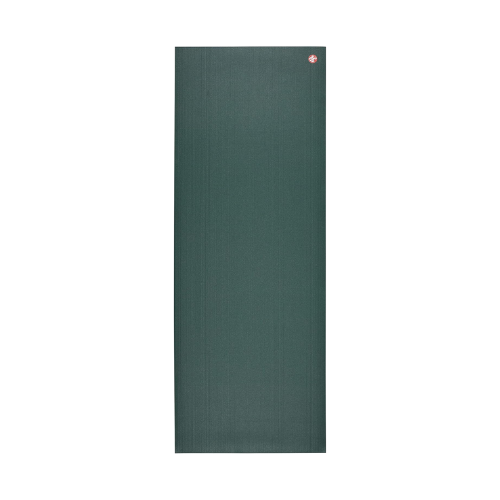
BEST OVERALL
Manduka Pro Yoga Mat
Buy Now On Amazon
Buy now at rei co-op
Buy now at manduka
The Manduka Pro Yoga Mat is a consistent favorite at SPY and among seasoned yogis and instructors. Duran loves this 6-millimeter-thick mat for its join-friendly cushion and balanced grip. He does note that the closed-cell surface, while antimicrobial, can become more slippery when wet, so keep a hand towel within reach if your sessions get sweaty. Like a fine wine, however, this mat ages beautifully with time, and does become grippier the more you use it. It’s also covered by a lifetime guarantee.
Renowned for its high quality and longevity, this luxe mat is sustainably made with OEKO-TEX certified-safe PVC and closed-cell materials to keep your practice hygienic and safe. Ultra-dense and comfortable, it feels secure on any surface thanks to the non-slip bottom, and its spacious 71 by 26-inch dimension allows room for most to flow–they make a long version for the tall yogis, too.
At $138, the Pro is one of the priciest options on our list. But considering users get several years of practice from it, SPY considers this mat an exceptional, worthwhile investment.
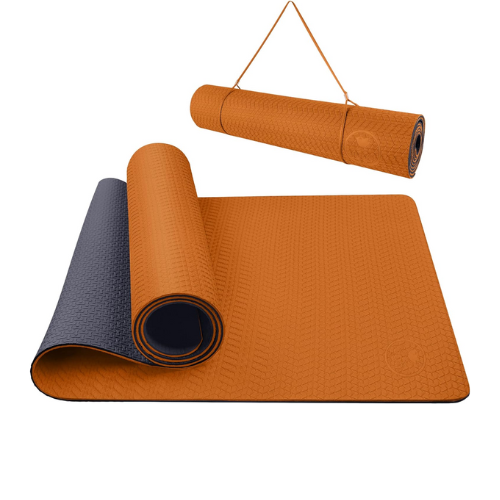
BEST BUDGET
IUGA Yoga Mat (Non-Slip, Anti-Tear, and Eco-Friendly)
Buy Now On Amazon
This IUGA Yoga Mat is proof that you don’t have to go broke to secure a solid mat. Crafted from eco-friendly TPE, this wallet-friendly mat delivers top-notch durability and performance without breaking the bank. Thanks to a double-sided non-slip surface, it provides a reliably versatile foundation for several modes of exercise beyond a yoga ritual. Its 6-millimeter cushion strikes the perfect balance, offering firm stability for precarious standing positions while remaining soft on wrists and joints.
Not only is this thrifty mat one of SPY’s most lightweight mats at just two pounds, but it’s also durable with an impressive grip for both beginners and intermediate yogis to lean into every downward dog, side plank, or tree pose. The mat’s open-cell design efficiently absorbs sweat, maintaining its grippy texture even during intense classes.
With comparable quality to some pricier alternatives, the IUGA Yoga Mat is an impressive value for $37 and even comes with a free carrying strap.
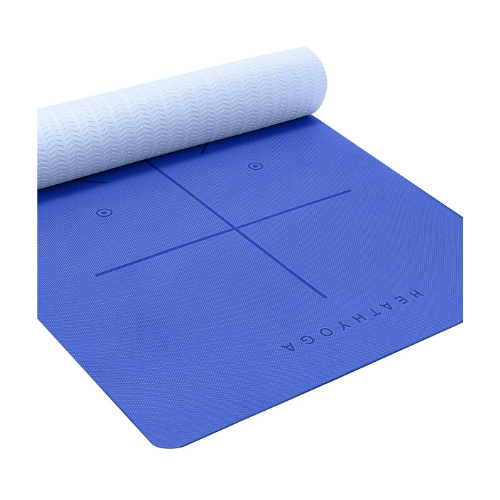
BEST FOR BEGINNERS
Healthyoga Eco-Friendly Non-Slip Yoga Mat
Buy Now On Amazon
If you’re just getting into yoga, this mat with alignment markings can help guide you through the learning curve. Like a set of training wheels on a bike, the attractive and subtle design gives starter yogis a reference point for angles and body, feet, and hand positioning, which can help with balance, form, and focus, SPYs experts say.
Beginners love its 72 by 26-inch size that gives ample room for error, should you lose your balance, but the textured grip and firm, double-sided surface provide a stable platform for mistakes. As stable as it is, it’s still comfortable for newbies with tender joints and knees, thanks to 6 millimeters of cushion. And fresh yogis will find caring for this mat easy thanks to its close-celled construction that repels sweat and dirt — but don’t forget to pick up a mat towel at checkout for your hot yoga sessions.
This durable, eco-friendly TPE mat is also super affordable, too, at just $40, another great selling point for beginners testing the waters of their new habit, says Duran. With the savings, you can invest in extra instruction that will have you glancing at your mat less and less!
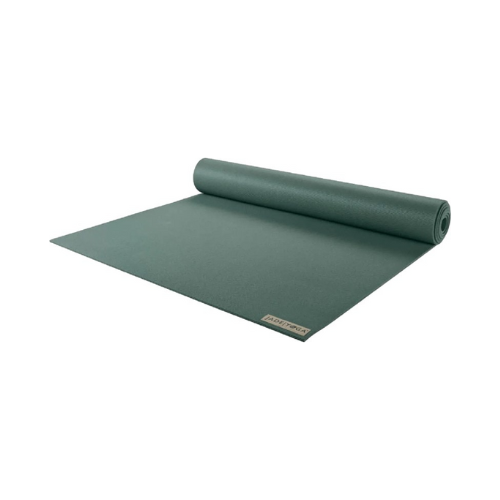
BEST FOR HOT YOGA
Jade Harmony Professional Yoga Mat
Buy at rei co-op
Buy at yoga accessories
Buy at bed bath & beyond
Buy at jade yoga
If you’ve ever done a power flow, you know the benefits of an extra grippy, non-slip mat like Jade’s Harmony Professional Yoga Mat. “As far as picking the right mat, one thing that I definitely look for is a non-slip mat, especially if it’s a heated class,” says Duran. “I’ve practiced on, but don’t own, a Jade mat, and they’re really good. I like the non-slip [open cell] material.” With its open cell construction, and grippy, natural rubber the Harmony combats sweat and humidity when classes get steamy.
With the “just right” level of 5-millimeter cushion and support, the Harmony mat lives up to its namesake as a balanced feature mat that’s also eco-consciously made with fully biodegradable, natural rubber. Jade even plants a tree for every mat it sells (which are USA-made, by the way), so if sustainability and lessening your ecological footprint is your jam, Harmony is your mat.
This mindfully made mat retails for $92, which is steeper than some, but certainly worth every penny if you want a high-quality, eco-friendly mat to support your practice through any session intensity or environment.
Also Consider: Lululemon’s The Mat is another super grippy, open-cell natural rubber mat that Duran personally uses in his practice for its non-slip features. It comes in a standard and extra spacious size (one of SPY’s list of top yoga mat picks) and is also sustainably made.
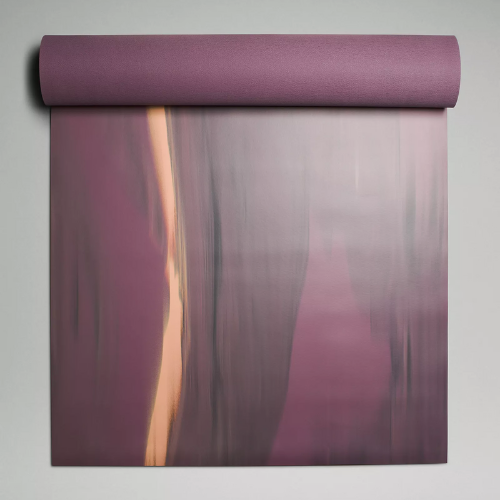
BEST EXTRA-LONG
Lululemon The Big Mat
Buy Now
Yogis who require (or merely prefer) a more sizable mat will love this roomy 28 by 84-inch mat by Lululemon. The (Big) Mat features the same open-cell construction (with an antimicrobial additive), and 5-millimeter cushion as The Mat (Lululemon’s standard version), Duran’s personal favorite and the one he uses in his practice. This larger version is double-sided with textured natural rubber on one, and smooth polyurethane on the flip for a variety of grip and workout versatility.
“One surface has a little bit more grip to it for the ground, which I really like because I find I don’t really slide [with it],” he says. “I have one for outside and one for inside!” Both sides offer exceptional wet and dry grip versatility, with the smooth side adapting to increased grip and absorbance when wet. Note: this mat isn’t latex-free, so those with rubber or latex allergies should avoid this mat.
The (Big) Mat rolls up tightly and is also relatively lightweight for its size, weighing 7 pounds (the same weight as some smaller, thicker mats). It is a little spendy with its $124 price tag, but you do get quality and quite a bit of comfortable real estate for the investment.
Also consider: If you’re on a budget, Giam’s Athletic Yoga Seriew dynMat Xtra-Wide Mat is a comparably spacious mat with dimensions of 78 by 26 inches and ample 5-millimeter thickness at a wallet-friendly price point. And if you’re after a group session, say with a partner, a couple of BFFs, or the kiddos, Gorilla Mats Premium Large Yoga Mat spans 7 by 5 feet floor space–enough to fit a few yogis — and features 8 millimeters of dense, grippy cushion for barefoot practice, pilates, or strength training sessions. This big mat comes in even more sizable options to equip your personal studio.
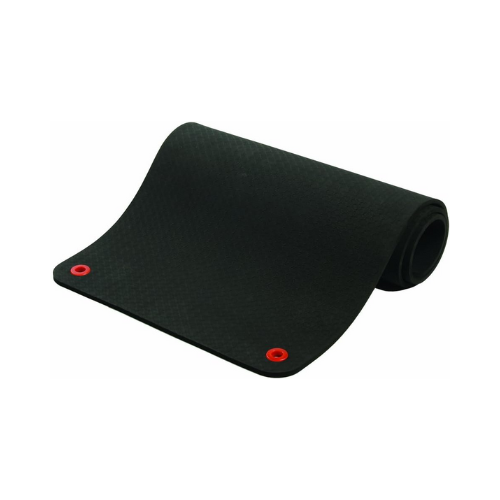
BEST FOR HOME GYMS
SPRI Hanging Exercise Mat
Buy Now On Amazon
Buy at get actV
Buy at fitness 1st
For an extra versatile, extra thick yoga mat with a built-in storage solution, SPRI’s Hanging Exercise Mat has two sturdy grommets on one end for ease of use in any home studio. Not only does this space-maximizing mat come in two different sizes, a petitely compact 56 by 23 inch and a 71 by 23 inch (standard yoga mat dimensions), but there are two thicknesses to choose from, an ample 9.5 or extra plush 15.9-millimeter cushion.
But don’t let “thick” be mistaken for pillowy, as the mat is made from dense, commercial-grade foam to transform your space into a personal gym. In fact, this mat lays nice and flat, providing a stable surface for yoga, lifting, HIIT, and so much more. The best part: when you’re done, sanitize the closed cell surface and hang it on your wall–no rolling required!
At most, this heavy-duty mat costs $70, depending on the size. Considering the beating it can take, as well as the versatility, it’s a perfect space-efficient accessory for any fitness-minded yogi.
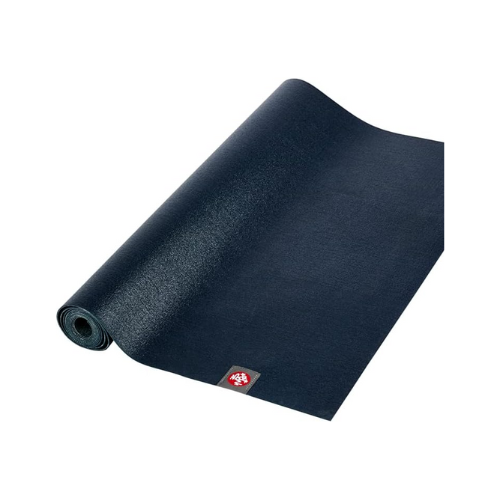
BEST FOR TRAVEL
Manduka EKO Superlite Travel Yoga Mat
Buy Now On Amazon
Buy at zappos
Buy at dicks sporting goods
Jett-setting yogis will love this lightweight, travel-friendly mat that folds or rolls small for toting in a suitcase or bag so you never have to miss a session on the go. Made from non-toxic, eco-friendly natural rubber, this 24 by 71-inch yoga mat is a standard size, but thin (1.5 millimeters) and super light, weighing a mere 2.2 pounds.
Like the Manduka Pro Yoga Mat, this mat’s made with a closed cell, antimicrobial surface to lock out moisture, odors, and bacteria, making it a bit slicker than others, but it does get even better and grippier the more you use it. This makes it ideal for getting in your Vinyasa flow wherever you go, then safe to stow in your suitcase afterward without causing a stink.
Splurging on a second mat might seem a little “extra,” but at a reasonable $52, you and your practice will thank us later.
Also consider: An honorable mention shoutout to another mat we love with similar portability and performance is the Yoloha Yoga Travel Cork Yoga Mat, which weighs a slight 2 pounds and also folds or rolls for easy packing.
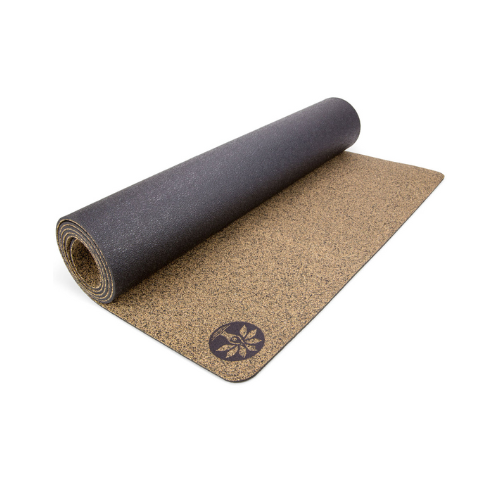
BEST OUTDOOR
Yoloha Yoga Unity Cork Yoga Mat
Buy Now
Earthy yogis who practice outdoors might want to consider Yoloha Yoga’s rugged Unity Cork Toga Mat. Made from natural cork and recycled rubber, this firm 6.5-millimeter mat is extra durable and stable atop sandy, grassy, or rocky terrain. Supported by 3 millimeters of dense rubber underfoot, it provides ample protection and a grounded feeling against the elements. And when your sun salutations heat up, the Unity’s smooth, antimicrobial cork surface acts quickly to absorb moisture for enhanced grip when wet so you can reach for the sky without faltering.
To accommodate all kinds of outdoorsy yogis, the Unity comes in a spacious standard size, 72 by 26 inches, along with two larger dimensions, an 80 by 26-inch plus an even more generous 84 by 30-inch mat. And appropriately, the mat is sustainably made in the United States with a carbon-neutral delivery option via EcoCart for mindful shoppers who want a minimal impact on the environment with the mat purchase.
This versatile and long-lasting indoor-outdoor mat does come with a higher price tag of $160 (standard size), but many consider the mat a wise investment in the planet’s future, as well.
Frequently Asked Questions About Yoga Mats
Can I Use An Exercise Mat For Yoga?
Exercise mats, such as foam pads, pilates mats, or weight lifting mats, vary in thickness, grip, and size than a standard yoga mat. For example, pilates mats are squishier to protect the pelvis during pilates moves while lying on your back, side, stomach, etc., Duran explains. “For yoga, you want something that doesn’t ‘give’ that much when you’re on your feet, especially if you’re doing balanced-based stuff,” he says. Some cushioning helps protect the knees, elbows, and joints, but since balance can already be challenging, you’ll want a proper yoga mat with ample grip that lets you feel connected to the ground as you move through your flow.
Is Expensive Always Better When it Comes to Yoga Mats?
More expensive yoga mats often offer higher-quality materials, durability, and features such as double-sided textures, enhanced grip, and sustainability. However, while a pricier mat may provide additional benefits, the best yoga mat for you depends on your individual preferences, needs, and budget. Whether you prioritize sustainability, grip, or longevity, all levels of yogis still have plenty of budget-friendly options that can offer adequate support and performance.
“There’s nothing wrong with buying a mat off Amazon for $30, especially if someone is just getting into their practice,” says Duran, who understands how newbies trying yoga for the first time might be unsure of how deeply they want to commit, and only require a starter mat for once or twice a week. “What I find, usually, is that once you realize that you enjoy whatever it is that you’re doing (whether it be yoga, Pilates, or cycle) and get into the habit, you’ll want to invest more into it.” That said, Scott warns against going too thrifty on your mat purchase, even as a beginner. “Cheaper mats often break down quickly, are slippery, or bulge when you move,” says Scott, so gauge your investment according to your intention and frequency of practice, support needs, and comfort preferences.
Are There Any Yoga Mats I Definitely Shouldn’t Buy?
While there isn’t “one mat to rule them all,” there are certain yoga mats you might want to avoid based on your specific needs and preferences. Mats made from low-quality materials, such as cheap PVC or foam may lack durability and support, leading to a distracting or unsafe yoga experience. Mats with poor traction, strong chemical odors, or those that don’t roll out flush with the ground can hinder your practice and even pose health risks, so it’s essential to research and invest in a mat from a trustworthy brand.
“I’m not trying to tell someone that going to Target and picking up just a basic mat there wouldn’t be great (because it potentially could be),” says Duran, “but if your practice is a regular habit, I would invest a little bit more.” He suggests spending money on a mat that has the kind of features you need and prefer and placing less emphasis on those you don’t. For example, a fitness and yoga instructor with a dance background, Duran prefers a thinner, grounded mat that still has enough cushion for his sensitive knees, which he finds many low-end mats don’t provide. Sometimes spending a little bit more to get a feature you want or need is worth it.
How Do I Clean a Yoga Mat So It Doesn’t Smell Like Feet?
Yoga mats (especially more porous, open-cell mats) can become breeding grounds for sweat, grime, odor-causing bacteria, and other germs, which can make you and your neighboring floor mates sick. To keep your yoga mat fresh, regularly wipe it down with a clean towel after each use to remove sweat and bacteria, according to the manufacturer’s instructions, since some materials can break down with certain cleansers. Duran recommends using warm water and a gentle cleanser, while Scott prefers a naturally antiseptic solution such as water and a little bit of tea tree oil–again, depending on the mat material.
For a deep cleaning, every so often, some brands suggest equal parts water and white vinegar then gently scrub the mat with a soft cloth or sponge. Several companies also make natural and gentle mat cleaners. Always let your mat air dry thoroughly to eliminate odors and maintain the mat’s freshness for your next practice. Expert tip: Duran also suggests high-grip yoga socks can be helpful for a more hygienic practice, especially if you share a mat, and recommends washing your hands after each session, too.
What’s the Best Way to Store a Yoga Mat?
After you use your mat, roll it up, rather than folding it, to prevent creases and damage to the material, says Duran. Store your rolled mat in a dry, well-ventilated area away from direct sunlight and extreme temperatures, like a closet or corner of a room–somewhere easy to access–so it maintains its shape and integrity. He also says it’s worth investing in a handy yoga mat sling, straps, or bag with additional storage that’s easy to grab and go while doubling as protective storage to keep your mat clean and protected.
Proceed to Checkout
More Top Deals from SPY
Best of SPY
